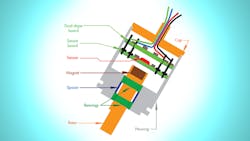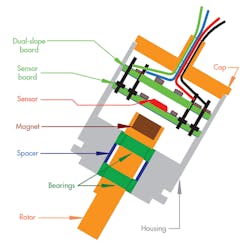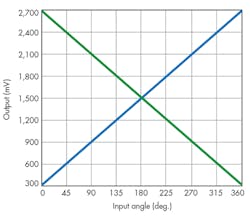Hall Sensor Measures 360 Deg. of Rotation
This file type includes high resolution graphics and schematics when applicable.
The sensors do not require any additional hardware to obtain or decode the linear measurement or control signals, which means software is also unnecessary. Because the sensor supplies signals for two slopes, engineers can insert the device directly in the system and have the desired slope—again, without adding hardware.
The sensor uses two ABEC Class-5 ball bearings on each rotor shaft for the servo-mount design, and anodized aluminum bearings are used on the threaded journal potentiometer-mount types. The sensor comes in three different mounting configurations in standard sizes and shapes, so no special mounting hardware is required for adding it into most new or existing systems.
The device is powered by 4.5 to 5.5 Vdc at 12 ma, and unregulated power supplies are acceptable. The output signals range from 300 to 2,700 mV. It works in temperatures from −20° to 85°C and relative humidity from 0 to 95%.
This file type includes high resolution graphics and schematics when applicable.




